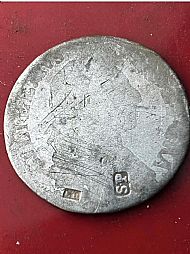SLAP TOKENS
Like many of my fellow detectorists, I am committed to submitting any suitable detecting finds I come across to the Portable Antiquities Scheme for recording on the database, as it adds to the local history and that of our country as a whole.
Since taking up the hobby I have slowly become familiar with any items of potential interest, but occasionally I do come across something which I cannot identify but I know it’s something, so I take such items to the Finds Liaison Officer’s for identification.
One such item was a small silver disc I found at a rally at Rocester, in Staffordshire a few years ago. Rocester, having strong links with the Romans I went to this rally with the hope of finding a bit of Roman, but sadly not that day. Just a lead weight, two buttons, a George V half-penny, and this little silver disc, which I thought at first was a very worn hammered coin, but on closer examination I could see letters and symbols stamped on both sides. One side was stamped a ‘+’ and an ‘R’ with a crown above it. On the other side, there is a stamped image of what looks like a castle.
I carried out some research online but could not then find out what I had found, not until a chance posting on a Facebook group identified my find as a ‘Slap Token’. Having never heard of ‘slap tokens’ before, more research followed (researching finds to me is a major part of our hobby) and this is what I found out.
Rob Blunt comments on the UKDFD forum that 'slap tokens' are ‘Irish countermarked tokens that are worn silver hammered coins, shillings, groats, countermarked with the initials or merchants and used as trade tokens.’ They seem to have been popular during the late 18th century and the early part of the 19th with Dublin being the main centre of use.
The main reason they were being used is that Ireland was neglected when it came to the minting and supply of silver coinage back then and so a shortage was created. These tokens were counter-stamped with numbers, letters, and symbols of traders to give them some form of legitimacy with the public.
Mainland Britain also seemed to have suffered a shortage of small silver coins as slap tokens are frequently found by detectorists here, myself included. Even the Bank of England back then issued silver tokens to offset the shortage, in fact a fellow detectorist recently found a lovely Bank of England silver 3 shillings token dated 1811.
Between 1816 -1817, a complete overhaul of silver coinage took place in Britain, which basically put an end to the need for tokens anymore, but it is interesting to come across these little items. Sadly, there hasn’t yet been a definitive identification list of the marks on these tokens, but we should still get them recorded for future research.
Whether my 'slap token' is from Dublin, who can say? although the little castle stamp could be indicative of Dublin Castle, or even Edinburgh, which uses a castle as its hallmark on silver.
Either way, I am happy to come across these little items, although a silver hammered would also be welcome……
2025 update - I have downloaded several photos of slap tokens which have been found by fellow Detectorists and posted on social media, as having some sort of a record for these little discs, as I cannot find much information about them. So my thanks to those who have posted and hopefully continue to post photos of slap tokens.
© Penny Vickers


















